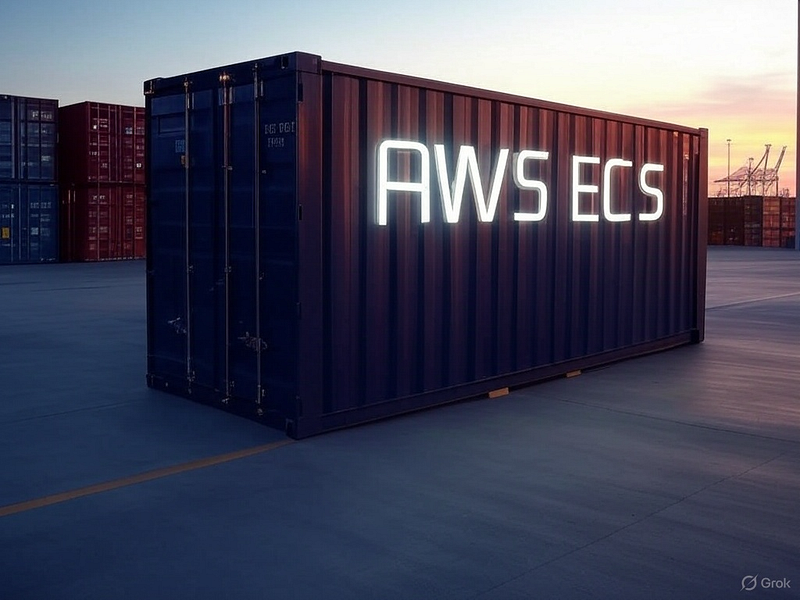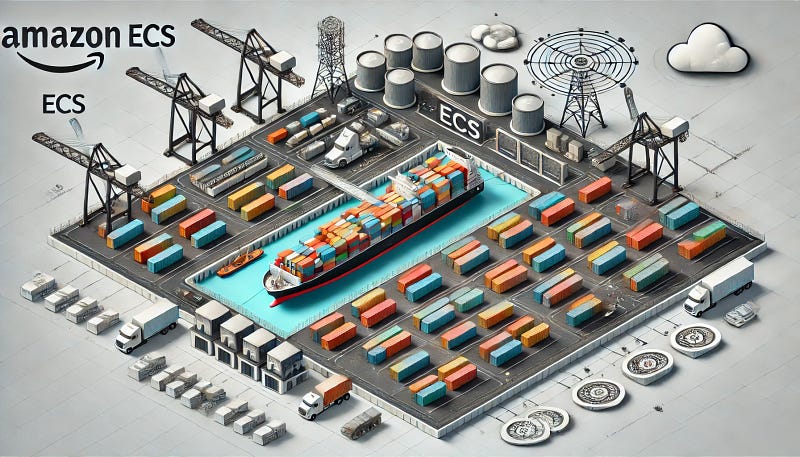Amazon ECS: The Container Shipping Yard Analogy 🚢📦
 Agilan Vageesan
Agilan Vageesan
Amazon ECS (Elastic Container Service) is a powerful, scalable container orchestration service that enables developers to run, manage, and scale containerized applications. But how does ECS work? Imagine ECS as a large shipping yard, where containers (applications) are efficiently managed, loaded, and transported using well-defined rules and automation.
In this guide, we will explore Amazon ECS concepts, security, deployment strategies, storage, networking, auto-scaling, task placement strategies, ECR, AWS CoPilot, and key certification exam topics using the shipping yard analogy to make it intuitive and easy to understand. 🚀
🚢 ECS Overview — The Shipping Yard
Think of Amazon ECS as a massive shipping yard where containers (applications) are stored, organized, and deployed based on demand. Just like shipping yards are divided into loading docks, security zones, and transport routes, ECS has clusters, tasks, services, and networking configurations to efficiently manage containerized applications.
Key Components of ECS
ECS Task 📦 — A single shipping container, carrying an application workload.
ECS Service 🚛 — A fleet of delivery trucks ensuring containers (tasks) stay active.
ECS Cluster 🏗️ — The shipping yard that organizes and manages all containers.
Task Definition 🔗 — The blueprint for loading and managing containers.
Fargate ⚙️ — An automated crane that handles container movement without human intervention.
EC2 🛠️ — Manual handling by dock workers, where full control is required.
Real-World Example: Food Delivery Service 🍕🚚
Imagine a food delivery company like Uber Eats:
Each food order = an ECS Task 📦 (A single, packaged workload)
A delivery rider = ECS Service 🚛 (Ensures continuous order fulfillment)
The city’s food delivery network = ECS Cluster 🏗️ (Handles all orders and delivery operations)
A restaurant’s menu = Task Definition 🔗 (Defines how meals should be prepared and packed)
Automated dispatching = Fargate ⚙️ (Handles everything behind the scenes)
Manual restaurant operations = EC2 🛠️ (Gives full control to restaurant owners)
Each element ensures efficiency, security, and scalability, just like a well-managed shipping yard.
📦 ECS Task Placement Strategies — How Containers Are Distributed
Task Placement = Deciding Where to Place Containers in the Shipping Yard
In ECS, Task Placement Strategies determine how tasks are scheduled and distributed within a cluster. Just like a shipping yard strategically places containers to optimize space and efficiency, ECS ensures containers (tasks) are placed correctly based on workload needs.
🚀 Task Placement Strategies:
Binpack Strategy 📦 — Like stacking similar-sized shipping containers together to save space, ECS places tasks on the least-utilized EC2 instances to optimize costs.
Spread Strategy 🌍 — Like evenly distributing goods across multiple warehouses, ECS spreads tasks across all available instances for high availability.
Random Strategy 🎲 — Assigns tasks randomly without specific optimization (rarely used).
AZ Balanced Spread Strategy 🏢 — Like distributing inventory across multiple warehouses in different cities, ECS spreads tasks evenly across Availability Zones (AZs).
📌 Hands-On: Implement Binpack vs. Spread Strategy in ECS and observe task distribution.
🔄 ECS Cluster & Services — Managing Container Workloads
Creating an ECS Cluster
An ECS Cluster is like setting up a new shipping yard 🏗️. It holds all the containers (tasks) and ensures efficient operations.
📌 Hands-On: Create an ECS Cluster via AWS Console, choosing Fargate or EC2 as the launch type.
Creating an ECS Service
An ECS Service ensures that a set number of tasks (containers) are always running, similar to how a delivery fleet ensures orders are always fulfilled.
📌 Hands-On: Deploy an ECS Service and configure auto-scaling.
Scaling ECS Workloads
ECS allows automatic scaling to meet demand fluctuations. Strategies include:
Target Tracking Scaling — Adjusts the number of tasks based on metrics like CPU usage.
Step Scaling — Adds or removes tasks based on defined threshold limits.
Scheduled Scaling — Scales up or down based on predefined schedules.
📌 Hands-On: Configure ECS Auto Scaling with Target Tracking.
🔄 ECS Deployment Strategies — Rolling Out New Versions
ECS Deployments = Shipping Route Adjustments
Deploying new application versions in ECS is like rolling out new shipping routes.
🚀 Deployment Strategies:
Rolling Update — Gradual replacement of old tasks with new ones.
Blue/Green Deployment — Deploy new tasks separately before full rollout to reduce downtime.
Canary Deployment — Release updates to a small percentage of users before rolling out to all.
📌 Hands-On: Deploy a new version of a containerized app using Rolling Updates.
📦 Amazon ECR — Storing Container Images
ECR = A Warehouse for Shipping Containers
Amazon ECR (Elastic Container Registry) stores container images, just like a warehouse stores cargo before shipping.
📌 Hands-On: Push a Docker image to Amazon ECR and deploy it using ECS.
🤖 AWS CoPilot — Simplified ECS Deployment
AWS CoPilot = Automated Dock Management
AWS CoPilot makes it easier to deploy and manage ECS workloads.
📌 Hands-On: Deploy an ECS service using AWS CoPilot.
📜 Amazon ECS: Certification Exam Tips & Questions
✅ Know when to use Fargate vs. EC2 (Fargate = serverless, EC2 = full control).
✅ Understand Task Definitions (What they include and how they control containers).
✅ Networking modes: AWSVPC mode is best for isolation and security.
✅ Auto Scaling uses Target Tracking for demand-based scaling.
✅ Deployments: Blue/Green minimizes downtime, Rolling Updates are gradual.
✅ EFS is preferred for persistent storage shared between containers.
✅ Task Placement Strategies determine task distribution across a cluster.
💡 Example Question: You need to optimize ECS task placement to minimize costs while maximizing resource utilization. Which placement strategy should you choose? ✅ Answer: Binpack Strategy 📦

🔚 Conclusion: Mastering ECS for Containerized Applications
Amazon ECS is a powerful container orchestration service designed for scalability, automation, and cost optimization. By understanding ECS through the shipping yard and food delivery analogies, you can confidently manage and deploy containerized applications at scale. 🚢
Subscribe to my newsletter
Read articles from Agilan Vageesan directly inside your inbox. Subscribe to the newsletter, and don't miss out.
Written by
